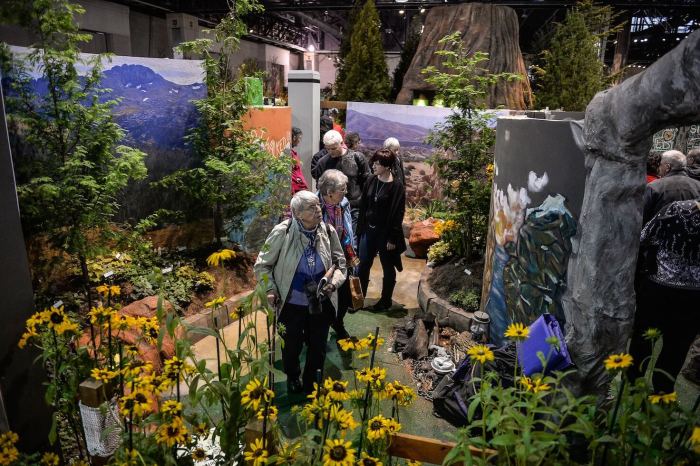All too often, houseplants look great just long enough to make one solid appearance on Instagram. Then they suddenly begin to droop and no matter what you do, you can’t bring them back to life. But fret not — Taylor Johnston, horticulturalist at the Isabella Stewart Gardner Museum and founder of Gamine Workwear, shares her best tips for keeping your plants happy and thriving.
1. Pick plants based on availability of light: Johnston says different types of plants need different amounts of light. So one way to go about picking a houseplant is to look at how much sun your home gets.She gives cacti as high light options, philodendron as medium light, and Boston fern and Norfolk pine as ones that prefer low light.
2. Changes are gradual: Sometimes it’s hard to tell when you’re plant is growing, which leaves you wondering if your plant is growing at all. Johnston adds,“Plants move very slowly, so you really have to train your eye and be comfortable not knowing the answer.” RELATED:Architect designs modern tree house 3. There’s no checklist of rules:
You can go to the Internet, gardeners, family and friends and everyone’s going to tell you something different about how to take care of your plants. Johnston stresses that “e
veryone’s environment is different and what works for me and what works for you probably are going to be two different things. That goes for how many days a week we water, how often we’re turning our plants to make sure they’re getting even exposure to light.”
4. Withhold water: The one thing everyone knows to do is water your plant. Most people don’t realize overwatering might actually be the problem.So no matter the situation, whetheryou get little gnats flying out or you see leaves drooping, Johnston advises withholding water and using a sticky trap for the gnats. “A lot of times, a plant displaying symptoms of too much water, will look like a plant that has not enough,” she adds. 5. Feed your plant: Fertilizing is an often forgotten, but important, task.Your plants need food in addition to sunlight and water.Johnston shares that shedoesn’t use liquid feed, but if she does, she dilutes them. “No matter what the packaging says, ignore it, cut it in half,” Johnston advises. As an alternative, she uses Osmocote, which is a slow release fertalizer that gives a little bit of food every time you water.
7. Plants are intelligent:Johnston emphasizes that plants are incredibly smart living organisms. And the environment around them — the people, temperature, season and sounds — affect them. They respond to this stimuli in positive and negative ways.
8. When buying plants, make sure they’re green, healthy, and vibrant:Whenever you shop for houseplants, it’s always hard to tell which plant to buy. Is this one healthier than the other? What should I look for? They all look the same! Johnston’s go-to tip is to make sure there’s “nofungal grow on the surface of the medium [and] there are no gnats or other visible signs of pests like webbing.” 9. Buy the smaller pot:You’re at the nursery or garden store and find a plant your really like, but it comes in different-sized pots. Is the larger one better because it has more room to grow? To get the best bang for your buck, Johnston shares a secret: “Classically, somebody will put a much smaller plant in a much bigger pot and charge you a lot more money. So if you tap it out of the pot and you’re not seeing a ton of roots, probably just buy the smaller size because it’s the exact same plant.” 1
0. Don’t pick the one that’s in full flower:Many people purchase the plant with the most open flowers. It not only looks the prettiest, but you know exactly what you’re getting. At the same time, Johnston reminds us that “you have no idea how long it’s been in flower, probably a while. If you pick the one with the most un-open buds, you’re going to enjoy that plant for longer.” The plant will mostly likely flower after you bring it home. RELATED:How to add modern Americana into your home 11. Be wary of the Internet:It’s always a struggle taking care of plants and you may consistently worry if you’re doing it correctly or not. Horticultralists or local gardeners are great resources for information. The Internet, so readily availble at your fingertips, is another popular source. Johnston, however, believes the Internet can be dangerous.”Someone could be growing the exact same plant that’s the exact same age and it looks exactly the same, but you don’t know what’s going on behind the screen,” she says. 12. Know that you’re going to kill a lot of plants:It’s common to attempt to care for a plant, kill it and give up for fear of killing any more. But raising plants, “is something that requires a lot of patience and humor,” Johnston says. “You’re going to kill a lot of plants in your journey of tending them. And therein, you learn about yourself and become a better person as a result.” 13. Check out Opus Nursery in RI, Niche Urban Garden Supply in the South End and eBay:Who would ever think to go to eBay for plants? But Johnston enthuses thateBay is great. You can find a lot of “weirdo hobby growers. They’re the coolest people on earth to talk to and they have the best material,” Johnston says.
6. Play your plant music:Johnston is a firm believer that plants respond to extrasensory things, that they somehow have “ears” and playing music benefits their spirits. If you’re looking for some music ideas, she suggests“MoTown, jazz, things that are universally loved by people” as some options. “I think a quick search on Spotify will lead to a couple playlists.”
























